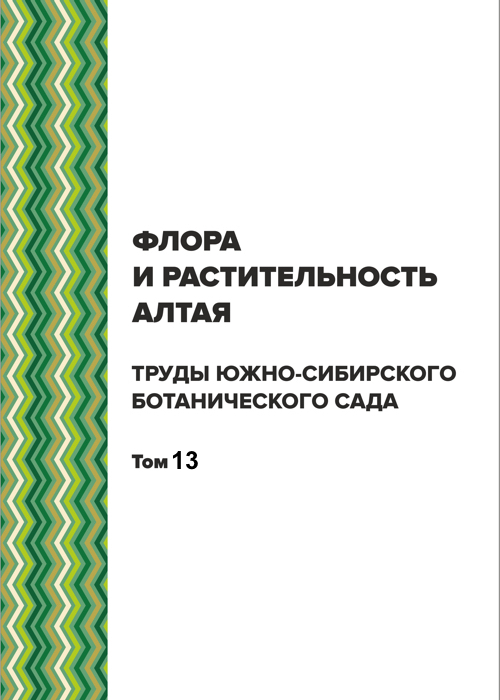ХАРАКТЕРИСТИКА ПРИГОДНОСТИ РАСТЕНИЙ СЕМ. POACEAE ДЛЯ РАЗВИТИЯ ЧЕРЕМУХОВО-ЗЛАКОВОЙ ТЛИ RHOPALOSIPHUM PADI (L.) (HEMIPTERA: STERNORRHYNCHA: APHIDIDAE)
Main Article Content
Abstract
В статье приводятся результаты изучения развития трех онтогенетических морф черемухово-злаковой тли – Rhopalosiphum padi (L.) – при питании на растениях 11 дикорастущих видов и 8 культиварах злаковых трав, входящих в комплекс кормовых растений тли, сформированный в процессе эволюции. На культивары оказались более благоприятными для питания тли, чем соответствующие дикорастущие виды. Setaria viridis L. отнесен к неблагоприятным хозяевам тли, а Phleum phleoides L. и Alopecurus arundinaceus Poir. – к благоприятным. Полученные результаты рекомендуется использовать для контроля мест размножения вредителя.
Article Details
How to Cite
Гандрабур Е. С., Верещагина А. Б. ХАРАКТЕРИСТИКА ПРИГОДНОСТИ РАСТЕНИЙ СЕМ. POACEAE ДЛЯ РАЗВИТИЯ ЧЕРЕМУХОВО-ЗЛАКОВОЙ ТЛИ RHOPALOSIPHUM PADI (L.) (HEMIPTERA: STERNORRHYNCHA: APHIDIDAE) // Flora and vegetation of Altai, 2022. Vol. 130. P. 44-47. URL: http://journal.asu.ru/flora/article/view/12445.
Section
Статьи
References
1. Гончаров М. Ю., Повыдыш М. Н., Яковлев Г. П. Систематика цветковых растений: учеб. пособие. Под ред. Д. Д. Соколова. – СПб.: СпецЛит, 2015. – 176 с.
2. Мордкович В. Г. Степные экосистемы. В. Г. Мордкович; отв. ред. И. Э. Смелянский. 2-е изд. испр. и доп. – Новосибирск: «Гео», 2014. – 170 с.
3. Цвелев Н. Н. Система злаков (Poaceae) и их эволюция. – Л.: Наука, 1987. – 75 с.
4. Angiosperm Phylogeny Group. An update of the Angiosperm Phylogeny Group classification for the orders and families of flowering plants: APG III // Botanical Journal of the Linnean Society. 2009. – Vol. 161, № 2. – Pp. 105–121.
5. Dixon A. F. G. Cereal Aphids as an Applied Problem // Agric. Zool. Rev., 1987. – № 2 (November). – Pp. 1–57.
6. Dixon A. F. G. Evolutionery aspects parthenogenetic reproduction in aphids // Acta phytopathol. et entomol. Hung., 1990. – Vol. 25, 1–4. – P. 41–56.
7. Emden van H. F., Harrington R. (Eds.) Aphids as Crop Pests. – CABI, London, UK, Publishing series, 2007. – 717 pp.
8. Finlay K. J., Luck J. E. Response of the bird cherry-oat aphid (Rhopalosiphum padi) to climate change in relation to its pest status, vectoring potential and function in crop-vector-virus pathosystem //Agriculture, Ecosystems and Environment, 2011. – Vol. 144. – Pp. 405–421.
9. Heie Ole E. The history of the studies on aphid paleontology and their bearing on evolutionary history of aphids. Aphids in a new millennium (Simon J.-Ch. et al. ed.). – Paris, 2004. – Pp. 151–158.
10. Parry H. R. Cereal aphid movement: general principles and simulation modelling // Movement Ecology, 2013. – Vol. 14, № 1. – Pp. 3–15.
11. Vereschagina A. B. Gandrabur E. S. Variability clones development parameters of bird cherry-oat aphid Rhopalosiphum padi (L.) (Homoptera, Aphididae) during life cycle as genotypic adaptations of this species // Entomological review, 2016. – Vol. 96(8). – Pp. 983–996.
12. Vereschagina A. B., Gandrabur E. S., Ephimov Development of the Bird Cherry-Oat Aphid Rhopalosiphum padi (Linnaeus) (Homoptera: Aphididae) Feeding on Unfamilar Host Plants of the Familes Cyperaceae and Juncaceae // Asian Journal of Microbiology, Biotechnology and Environmental Sciences, 2017. – Vol. 19(4). – Pp. 1094–1103.
13. Aphids on the World’s Plants. URl: http://www.aphidsonworldsplants.info
2. Мордкович В. Г. Степные экосистемы. В. Г. Мордкович; отв. ред. И. Э. Смелянский. 2-е изд. испр. и доп. – Новосибирск: «Гео», 2014. – 170 с.
3. Цвелев Н. Н. Система злаков (Poaceae) и их эволюция. – Л.: Наука, 1987. – 75 с.
4. Angiosperm Phylogeny Group. An update of the Angiosperm Phylogeny Group classification for the orders and families of flowering plants: APG III // Botanical Journal of the Linnean Society. 2009. – Vol. 161, № 2. – Pp. 105–121.
5. Dixon A. F. G. Cereal Aphids as an Applied Problem // Agric. Zool. Rev., 1987. – № 2 (November). – Pp. 1–57.
6. Dixon A. F. G. Evolutionery aspects parthenogenetic reproduction in aphids // Acta phytopathol. et entomol. Hung., 1990. – Vol. 25, 1–4. – P. 41–56.
7. Emden van H. F., Harrington R. (Eds.) Aphids as Crop Pests. – CABI, London, UK, Publishing series, 2007. – 717 pp.
8. Finlay K. J., Luck J. E. Response of the bird cherry-oat aphid (Rhopalosiphum padi) to climate change in relation to its pest status, vectoring potential and function in crop-vector-virus pathosystem //Agriculture, Ecosystems and Environment, 2011. – Vol. 144. – Pp. 405–421.
9. Heie Ole E. The history of the studies on aphid paleontology and their bearing on evolutionary history of aphids. Aphids in a new millennium (Simon J.-Ch. et al. ed.). – Paris, 2004. – Pp. 151–158.
10. Parry H. R. Cereal aphid movement: general principles and simulation modelling // Movement Ecology, 2013. – Vol. 14, № 1. – Pp. 3–15.
11. Vereschagina A. B. Gandrabur E. S. Variability clones development parameters of bird cherry-oat aphid Rhopalosiphum padi (L.) (Homoptera, Aphididae) during life cycle as genotypic adaptations of this species // Entomological review, 2016. – Vol. 96(8). – Pp. 983–996.
12. Vereschagina A. B., Gandrabur E. S., Ephimov Development of the Bird Cherry-Oat Aphid Rhopalosiphum padi (Linnaeus) (Homoptera: Aphididae) Feeding on Unfamilar Host Plants of the Familes Cyperaceae and Juncaceae // Asian Journal of Microbiology, Biotechnology and Environmental Sciences, 2017. – Vol. 19(4). – Pp. 1094–1103.
13. Aphids on the World’s Plants. URl: http://www.aphidsonworldsplants.info

